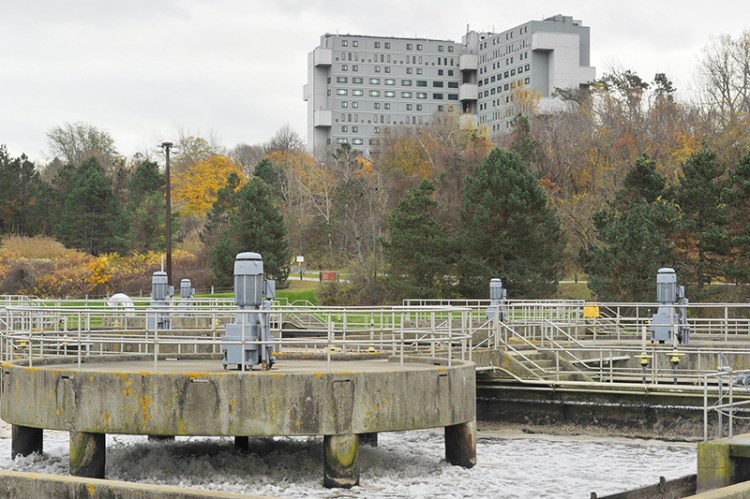Portland Water District officials say that a $12 million upgrade to the city’s wastewater treatment plant helped lower nitrogen discharges that feed algae blooms and reduced neighborhood odor complaints last year.
And they’re hoping for similar results this summer.
The district completed installation of new aeration technology at the East End wastewater treatment plant last July and has been working with engineers to fine-tune the system since then. The new system uses 10,000 underwater “diffusers” to send tiny air bubbles through the massive pools of wastewater, creating an oxygen-rich environment ideal for the microorganisms that digest sewage and waste.
During periods last summer, that system helped reduce the average discharge of nitrogen – a component of waste – into Casco Bay from an estimated 2,400 pounds per day to 500 pounds. Plant officials also said they believe the upgraded system was a major factor in reducing the number of odor complaints about the plant from 106 in 2016 to 41 last year.
Scott Firmin, director of wastewater services for the Portland Water District, said the goal is to reduce total annual nitrogen discharges into Casco Bay by between 20 and 40 percent. Because nitrogen is a bigger problem during warmer months, the plant is gearing up for the summer as the district tests the capacity of the new system to reduce discharge levels.
On Wednesday, plant employees as well as representatives from the Maine Department of Environmental Protection, Friends of Casco Bay and other organizations gathered to celebrate the upgrade. The DEP helped the water district obtain $10.9 million in low-interest financing from the Maine Municipal Bond Bank, while Efficiency Maine provided a $203,000 grant for the equipment.
DEP Commissioner Paul Mercer noted the collaborative approach to addressing the long-standing wastewater and stormwater runoff challenges in Portland and around the state.
“There is so much more to do,” Mercer told the several dozen people gathered at the East End plant. “We have to keep working on it and we have to keep working together. We need to make sure Maine has the best water quality.”
The city of Portland is more than halfway through a roughly 40-year, nearly $250 million plan to reduce the amount of raw sewage flowing into Casco Bay and other waterways. Part of that is the massive city infrastructure projects underway on many streets, but another part is the recent capacity expansions and upgrades at the treatment plan.
In 2016, the city discharged 318.4 million gallons of combined sewage and stormwater overflow into surrounding waters during storm events. While that figure accounts for the largest share of discharges in the state, it represents a more than 80 percent reduction from the 1.8 billion gallons discharged into Portland’s surrounding waterways 30 years ago.
In recent years, Back Cove and several other areas around Portland have experienced large algae blooms – likely linked to excess nitrogen in the water – that threaten shellfish and other marine life.
Eliminating all nitrogen discharges from the treatment plant would cost an estimated $40 million. Ivy Frignoca, the Casco Baykeeper with Friends of Casco Bay, said she has been working with the Portland Water District for several years on more realistic approaches to address the problem in the near-term.
“This is a great solution,” Frignoca said of the new aeration system. “I really think it is going to make a big difference.”
Kevin Miller can be contacted at:
kmiller@pressherald.com
Send questions/comments to the editors.



